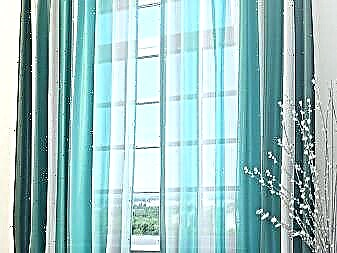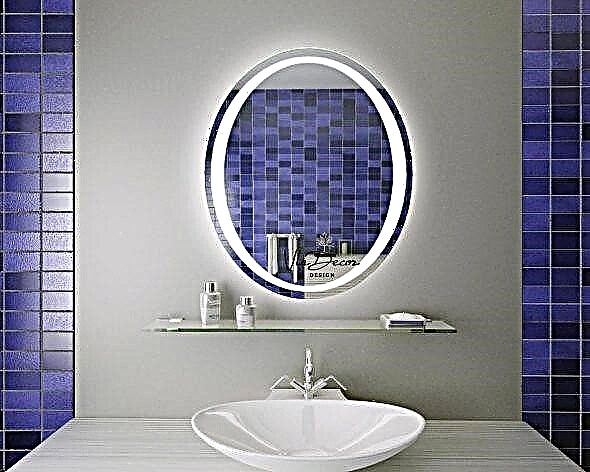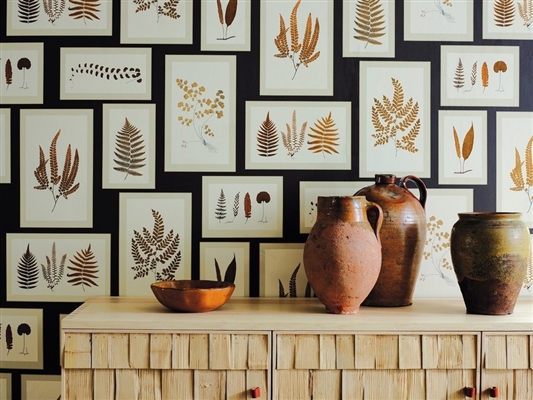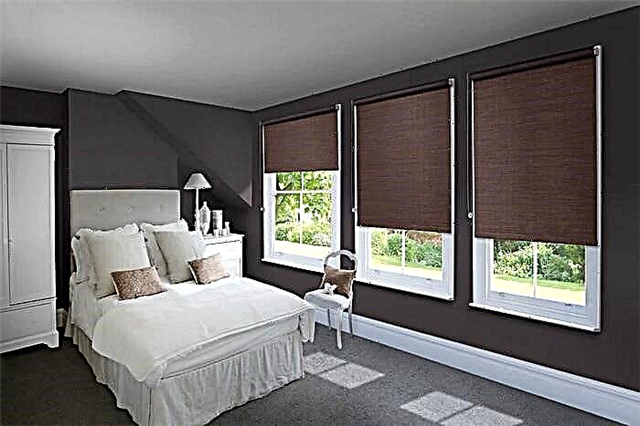
Saying “tulle”, we mean the fabric from which light curtains are sewn onto the windows, the main function of which is to close the person from those who are outside and meanwhile provide a good overview to those who are indoors. Tulle was invented in France for the bride of the king, who wanted to hide her face from the guests. Initially, it was made manually and only from natural silk and cotton threads.


Nowadays, tulle production is engaged in industrial scale and can use polyester for the base. Modern fashion allows the presence on the windows of tulle from a dense, rigid fabric, for example, organza. There are a large number of variations on how to organically fit organza into the design of the room.

What is the difference?
Now the concept of “tulle” includes all transparent curtains, which are also called “day curtains”, including organza and veil. Therefore, its differences from tulle can be called mythical - this is its variety. By the way, the word "tulle" is masculine.
Typically, organza is made from natural fabrics - silk and cotton, but now you can often find synthetic additives - polyester. Two fibers of the fabric are twisted together, forming a dense, well-holding fabric. Organza tulle can be matte and glossy, as well as with a pattern applied by printing, etching and even embroidery.




Benefits
Organza, according to a number of signs, is better than other fabrics in order to create a modern window design:
- This fabric is denser and stiffer than standard tulle, therefore, her service life is not limited to a couple of years, but easily reaches 8 or even 10 years without losing her appearance,
- organza is easily combined with almost all tissuesthat are used for sewing heavy night curtains,
- aboutrganza transparent, airy and in spite of its high density, it passes a lot of light,
- one of the differences from cheap fabric for windows is a high light fastness organza. Tulle from it does not burn out even on the south side,
- organza is easy to care for, it is erased not only by hand, but also in the machine, any dirt is washed from it.

However, with all the advantages, this fabric has its drawbacks:
- high cost of fabric. In the manufacture of a complex technological process that affects the increase in price,
- air doesn’t pass through this fabric therefore, it is better to make such curtains from two cuts, to regularly open them for ventilation,
- organza with the addition of polyester instead of silk does not form small forks on the windows, therefore, it is not recommended to use this material for small windows in small rooms from a design point of view,
- hooks easily remain on the fabric, therefore, if the house has a network of pets or small children, then hanging such a tulle on the windows is not recommended.
Fashion colors
This season is especially relevant monophonic tulle of natural natural colors: green, ocher, golden, yellow, blue. Squeak of fashion - beautifully combine two colors. If you don’t know how to combine color for your interior, choose white as the second tone. Such curtains will look advantageous in high-tech, Scandinavian and ethnic style.
However, beware of hanging white tulle on windows with white walls. There is a risk of "flying" with a touch, and then one thing will look dirty tone.
Embroidery, print options
Looks absolutely amazing on the windows of the organza with floral embroidery. These curtains will perfectly fit into a romantic style or Provence. As a rule, solid white is chosen as the background, on which a delicate pattern in the form of flowers is applied. In this case, the pattern is large, medium and small. The larger the pattern, the larger the window should be.
Organza with a printed pattern and a golden ornament has its own characteristics. Despite the strength of acrylic paint, it requires a hand wash without friction. It is not recommended to iron such curtains, the wet tulle is hung on the window and smoothed out under its own weight.

How to choose?
It is possible to choose fabric for curtains, proceeding from the most different aspects. One of them is the purpose of the room.
- For the bedroom curtains are selected in soft colors with good throughput for air. If you prefer twilight, then you can stay on the tulle of burgundy, blue, pale green shade.
- For kitchen organza - an ideal fabric, since it does not accumulate dust on its fibers, is easily erased, serves for a long time and does not fade in the sun.
- For a children's room you can also choose organza (but with regular curtains opening during the morning airing), its advantage is the same as for the kitchen - it can be easily washed off. For older children, you can choose cotton curtains.


A semiorganza, or microvual, is a light, soft, transparent fabric that looks like silk and is easily draped. This is ideal for windows that require soft, small folds.
How to hem?
Scissors, threads, a sewing machine and an iron are necessary for sewing curtains and tulle. If you have ceilings of the same height over the entire area of the room, you can align the lower edge of the tulle curtains by stretching one horizontal thread, and then trim the fabric with scissors along this reference point.
Since tulle is a sliding material that is constantly skewed, it is recommended to mark the length necessary for the hemline from the edge every 20 cm and put a thread of contrasting color along the marks. On it and cut off the edge.
- In the machine you need to thread the thread no thicker than 40 size. If the tulle from organza is brilliant, it is better to choose the thread two shades lighter. In sunlight, they will not be visible on the fabric, because a lighter tone is not so prominent than a darker one.

The needle in the machine should be sharp and thin so as not to cling to the fabric.
- Before you put the machine on the table, you need to cover it with a sheet. On cotton, the tulle curtain will not slip and skew, it will be much easier to sew.
- Before sewing, adjust the stitch of the sewing machine on an unnecessary piece of fabric. If the fabric is very thin and clings to the machine, sew it on tissue paper or tracing paper. After finishing work, they tear it off.
- Work starts from the side edgesbending them 1-2 cm and smoothing, sew at a distance of 1-2 mm from the inner edge of the hem.
- If the curtains have lace, scallops at the bottom, then adjust the length of the top.
- Organza is hemmed by at least 3 cm in the hemthat is, when cutting the length, leave 6 cm of allowance. The veil is hemmed by 2 cm, i.e. 4 cm of allowance from the desired length.


For more information about organza tulle hemming, see the video below.
Organza tulle: description, how it looks, examples of curtains
For the first time, tulle appeared in Europe in the 15th century in a small town, after which the material was named. He was weaved by weavers specifically by royal decree. The first tulle specimens were very smooth, light and at the same time dense enough to conceal a person’s face. Their structure resembled a network of very thin threads, which were woven manually. The most commonly used materials are from natural products such as silk or cotton.
Organza is a light and airy fabric that is made using a special technology of twisting fibers.
With the advent of special machines, it became easier to get tulle. It took less time to make it, and the fabric itself became more high-quality and diverse. From that moment on, tulle began to be produced with polyester elastic threads to create an original pattern.
Thanks to this method of manufacturing fabric, organza curtains are practical and aesthetic at the same time.
The popularity of tulle in Europe declined in the 18th century, when fabric called organza began to be supplied from the eastern side of the mainland. It was made entirely of processed silk threads and belonged to premium goods.
Organza was used for curtains when polyester and rayon were added to it, due to which the material became more accessible, elastic and transparent. The only drawback of the new organza is that it has become worse at letting air through, trapping dust and requiring additional care.
Organza consists of natural or synthetic fibers, is weightless and durable, transmits and scatters the sun's rays, easy to care for.
Organza: a description of the models, an overview of varieties, the structure and colors of the fabric
Today, organza products are 100% made up of synthetic fabrics that repeat the properties of the first fabric instances, namely: smoothness, lightness and luster.
Organza is perfectly combined with any material.
After the transition to machine production, the fabrication process has become much simpler and cheaper. Therefore, it is not surprising that they began to use it to the maximum in the interior and in the design of clothes. As a result, demand for more interesting varieties of organza has risen.
According to the materials used:
Silk is a natural fabric that is distinguished by its beauty.
Viscose, which is part of the tulles presented in this section, gives the fabrics a soft, silky texture.
Chiffon is a surprisingly light and airy material with an interesting relief texture.
By color reproduction:
For the classic style, choose a plain matte tulle in light shades.
Shiny tulle will be a special accent of the interior.
Chameleon tulles change color depending on the lighting.
By color palette:
Solid tulle fits the interior without a pronounced emphasis on a particular color.
Beautiful color tulle will be a great addition to your window.
By decorative structure:
To get a smooth tulle, use polyamide threads.
Crop tulle demonstrates a combination of good taste and practicality.
By decorative elements:
Curtains with photo printing are a breakthrough in the design of a window opening.
There are several options for applying print to organza. One of them is the seal. The drawing is applied to the fabric using a prepared stamp with paint. When the pattern is printed on the canvas, it is further processed to fix the ink. Another option involves applying the picture with oilcloth or chemical burning on dark canvases.
Every day, tulle with embroidery is becoming more popular.
The whole pattern, embroidered on the canvas of organza, is made using a special error for the formation of marriage. It is worth knowing about this type of organza: the fabric must necessarily consist of synthetic, denser threads, so that the embroidery does not make the fabric heavier.
Perforated curtains are a stunning design touch.
Throughout the canvas, they pass through a laser into which a specific pattern is programmed; it burns holes on the fabric according to the given coordinates. This type of organza organically looks in interiors in the style of minimalism.
Jacquard tulle is particularly luxurious in the interior space.
The imperial patterns are not able to withstand tulle, but organza is another matter. In the past, ornaments of houses with great prosperity were applied to it. After all, besides them, no one could afford to buy such material. Now jacquard is used in a classic interior style.
What is better tulle or organza: a comparative characteristic of fabrics
Organza tulle is a fabric that is often used as curtains for living rooms, such as bedrooms, nurseries, living rooms and kitchens. The main reason for choosing these fabrics is the following properties:
- Translucency,
- Ease,
- Ease of care
- A wide selection of colors, shades, patterns, etc.,
- Affordable cost.
Today, designers make extensive use of various styles to decorate windows.
However, organza and tulle are still not the same material, which means that they must have differences. So, for example, tulle has a number of disadvantages that should be taken into account, when choosing curtains there are also disadvantages.
- Tulle is a very soft and light fabric that is easily deformed under the influence of chemical and mechanical influences. Therefore, using this type of fabric is not the best option for a children's room or kitchen.
- Cream or white shade of the fabric is too transparent and poorly diffuse sunlight, so the tulle is not suitable for bedrooms. The exception is cases when a light tulle is complemented by massive curtains or more dense material.
- Tulle is worth hanging only not from the sunny side. This material has the ability to quickly fade. Otherwise, the canvas will constantly have to be changed or painted with dyes.
Fashion trends suggest the use of various types of organza in window decoration.
In terms of wear resistance, organza, of course, have significant advantages over conventional tulle. But do not miss the fact that the synthetic threads that make up the organza significantly affect the efficiency of air transmission and the dust-repellent properties of the material, unlike tulle.
Floor-length tulle will never go out of style.
Important! If there are people in the family who are allergic to dust, it is better to take curtains from tulle with the maximum number of natural threads. Such fabrics better allow air to pass through and do not trap dust.
Sewing organza curtains with your own hands: instructions on how to choose fabric, how to cut and sew curtains yourself
Gone are the days when organza was considered premium material. Now it is available to anyone who intends to diversify the interior of their room with new curtains. Moreover, two-thirds of the cost of new curtains is not so much the organza canvas itself as the processing of its edges, which can be done independently at home.
For those who like bright light, curtains made of light and light organza are suitable.
Sewing organza curtains with your own hands consists of only five stages.
To find out how much fabric you need to sew the curtains, you need to measure the width of the cornice on which the product will hang, and multiply the resulting figure by 1.5-2 times. Then the fabric will freely fall down, without stretch in width. Height is measured from the top of the cornice to the floor with an allowance of 2-4 cm for hemming the edges.
The sides where the fabric was cut are treated with a special invisible seam overlock to hide traces of thread.
Choosing the right colors for curtains is an important task.
- Bottom processing
To do this, you must additionally buy an oblique tape. First, the front side of the tape is sewn to the wrong side of future curtains. After the organza is wrapped in a ribbon and fixed with an invisible (secret) seam from the wrong side.
- Top processing
Additionally, a curtain tape is bought at any sewing store. It should be equal to the width of the structure itself. It must be sewn to the top of the canvas, where it will be attached to the cornice. After this, it is necessary to pull off the curtain, form the folds of the same size and hang the finished curtains on the ledge. Done.
You can combine tulle in several colors in decor and textiles for interior decoration.



